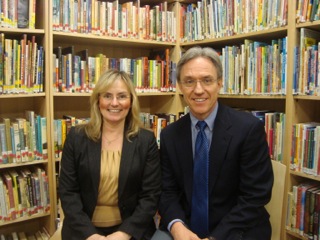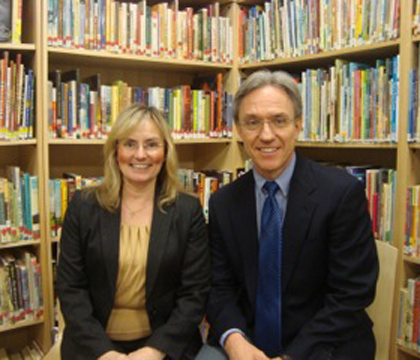That sentence is a mantra that risk and crisis communication experts Tim and Deanna Sellnow often repeat to their graduate students as they search for the most effective way to inform people about the risks of natural disasters, terrorism, contaminated food and other dangers.
"And we really believe in it. Whether we're communicating science or communicating instructions for self-protection, we can indeed use communication to reduce the harm that can be caused by crises," says Tim, associate dean of the University of Kentucky's Graduate Program in Communication where his wife Deanna is one of his colleagues. She is also director of the Division of Instructional Communication for the U of K and director of undergraduate studies for the university's Department of Communication.
The Sellnows, who have spent nearly two decades exploring ways to communicate to people before, during and after a crisis, will speak about their work during public lectures at the University of Saskatchewan on February 28 and March 1.

Their U of S visit is co-sponsored by the Western College of Veterinary Medicine, the Office of the Vice-President Research and the College of Arts and Science. A particular goal of their visit is to discuss the value of collaborative research between social scientists and researchers in the natural and health sciences.
The Sellnows have worked alongside everyone from experts in animal and food science, veterinary medicine, toxicology, food safety and public health to specialists in sociology, economics and international terrorism networks.
"Just recently, we've also been working with seismologists to more effectively communicate the risks of earthquakes," adds Deanna. "There are a lot of different areas of science that are seeing the value of collaborating with researchers in risk and crisis communication."
Tim's research focus is on emphasizing the message in risk and crisis communication. "A lot of previous research was related to psychology and how the brain responds to risk. What we've tried to argue is that we need to emphasize a message-centred approach to risk — as the words change, so does the perception of risk."
Deanna's research targets instructional communication: how to design a message that will resonate with people and motivate them to act in ways that reduce risk. The result of her work is an "idea model" that's grounded on people's four basic learning styles (watching, feeling, thinking and doing).
But rather than tailoring messages for specific learning styles, Deanna's research has shown that people will retain information and act more appropriately if the designed message touches on all four learning approaches.
"People will act, but they won't always act in the appropriate way. So it's really about designing the message and what sorts of channels and tools we use to reach the target audiences effectively," explains Deanna.
She adds that social media has introduced both new opportunities and new challenges to risk and crisis communication — something that most government agencies and companies were trying to ignore until a few years ago.
"Ultimately, they've realized that if they don't post or tweet, someone else will and it may not be the right message," says Deanna. "And if government departments or established companies do post, those are the messages that are being retweeted so it's a positive thing for them to interact with social media."
The Sellnows' research has led to consulting and research projects with government agencies such as the U.S. Department of Homeland Security, the Centers for Disease Control and Prevention, the U.S. Department of Agriculture and the National Center for Food Protection and Defense.
The impetus and funding for many of these projects stems back to 9/11 when nearly 3,000 people died in terrorist attacks upon the U.S. on September 11, 2001.
That traumatic day led to the creation of the U.S. Department of Homeland Security. Overnight, there was also an urgent need to design and develop messages that effectively informed the public about the risks of terrorism.
"A lot of our research focuses on food safety because the National Center for Food Protection and Defense believed that the country's food supply would be a vulnerable target for terrorists," explains Tim.
"The result is that the government has provided us with a lot of support to develop more research in risk and crisis communication. That's really helped the field to grow to the point where it's a prominent area of research and communication — and most importantly, an area of interdisciplinary research."
The couple's past PhD students are now working for the U.S. government as well as academic and research institutions. In addition, a number of their Master's students have graduated and taken on corporate management roles.
"These communication tools are not just limited to scientific organizations or to Fortune 500 companies," points out Tim. "These are the kinds of opportunities that are available for crisis planning and crisis management to organizations of any kind."
Much of the Sellnows' work focuses on the potential for bad things to happen to hundred, thousands — or even millions — of people. But rather than dwelling on the negatives, Tim points out that every crisis offers opportunities.
"If we respond to a crisis effectively, we can turn that seemingly negative event into a positive experience that will actually improve an organization," says Tim.
A crisis situation also enables researchers to understand the true makeup of an organization or track the spread of news stories covering a disaster, disease outbreak or terrorism attack.
"Crises really help us to understand how organizations and the media function under pressure," says Tim. "And the more we understand about crisis and risk communication, the better we can prepare."
"And we really believe in it. Whether we're communicating science or communicating instructions for self-protection, we can indeed use communication to reduce the harm that can be caused by crises," says Tim, associate dean of the University of Kentucky's Graduate Program in Communication where his wife Deanna is one of his colleagues. She is also director of the Division of Instructional Communication for the U of K and director of undergraduate studies for the university's Department of Communication.
The Sellnows, who have spent nearly two decades exploring ways to communicate to people before, during and after a crisis, will speak about their work during public lectures at the University of Saskatchewan on February 28 and March 1.

Their U of S visit is co-sponsored by the Western College of Veterinary Medicine, the Office of the Vice-President Research and the College of Arts and Science. A particular goal of their visit is to discuss the value of collaborative research between social scientists and researchers in the natural and health sciences.
The Sellnows have worked alongside everyone from experts in animal and food science, veterinary medicine, toxicology, food safety and public health to specialists in sociology, economics and international terrorism networks.
"Just recently, we've also been working with seismologists to more effectively communicate the risks of earthquakes," adds Deanna. "There are a lot of different areas of science that are seeing the value of collaborating with researchers in risk and crisis communication."
Tim's research focus is on emphasizing the message in risk and crisis communication. "A lot of previous research was related to psychology and how the brain responds to risk. What we've tried to argue is that we need to emphasize a message-centred approach to risk — as the words change, so does the perception of risk."
Deanna's research targets instructional communication: how to design a message that will resonate with people and motivate them to act in ways that reduce risk. The result of her work is an "idea model" that's grounded on people's four basic learning styles (watching, feeling, thinking and doing).
But rather than tailoring messages for specific learning styles, Deanna's research has shown that people will retain information and act more appropriately if the designed message touches on all four learning approaches.
"People will act, but they won't always act in the appropriate way. So it's really about designing the message and what sorts of channels and tools we use to reach the target audiences effectively," explains Deanna.
She adds that social media has introduced both new opportunities and new challenges to risk and crisis communication — something that most government agencies and companies were trying to ignore until a few years ago.
"Ultimately, they've realized that if they don't post or tweet, someone else will and it may not be the right message," says Deanna. "And if government departments or established companies do post, those are the messages that are being retweeted so it's a positive thing for them to interact with social media."
The Sellnows' research has led to consulting and research projects with government agencies such as the U.S. Department of Homeland Security, the Centers for Disease Control and Prevention, the U.S. Department of Agriculture and the National Center for Food Protection and Defense.
The impetus and funding for many of these projects stems back to 9/11 when nearly 3,000 people died in terrorist attacks upon the U.S. on September 11, 2001.
That traumatic day led to the creation of the U.S. Department of Homeland Security. Overnight, there was also an urgent need to design and develop messages that effectively informed the public about the risks of terrorism.
"A lot of our research focuses on food safety because the National Center for Food Protection and Defense believed that the country's food supply would be a vulnerable target for terrorists," explains Tim.
"The result is that the government has provided us with a lot of support to develop more research in risk and crisis communication. That's really helped the field to grow to the point where it's a prominent area of research and communication — and most importantly, an area of interdisciplinary research."
The couple's past PhD students are now working for the U.S. government as well as academic and research institutions. In addition, a number of their Master's students have graduated and taken on corporate management roles.
"These communication tools are not just limited to scientific organizations or to Fortune 500 companies," points out Tim. "These are the kinds of opportunities that are available for crisis planning and crisis management to organizations of any kind."
Much of the Sellnows' work focuses on the potential for bad things to happen to hundred, thousands — or even millions — of people. But rather than dwelling on the negatives, Tim points out that every crisis offers opportunities.
"If we respond to a crisis effectively, we can turn that seemingly negative event into a positive experience that will actually improve an organization," says Tim.
A crisis situation also enables researchers to understand the true makeup of an organization or track the spread of news stories covering a disaster, disease outbreak or terrorism attack.
"Crises really help us to understand how organizations and the media function under pressure," says Tim. "And the more we understand about crisis and risk communication, the better we can prepare."
Share this story
